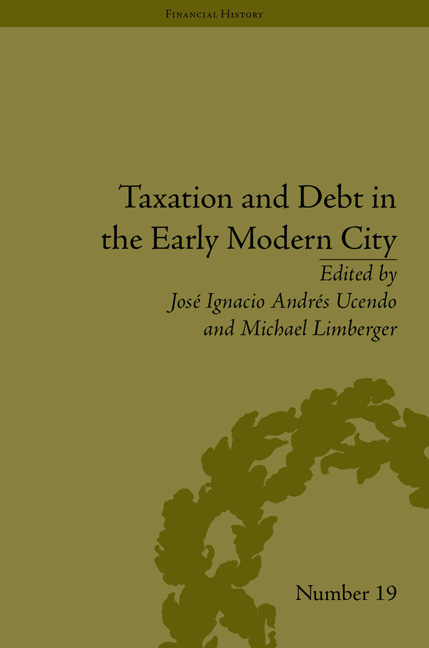Book contents
- Frontmatter
- CONTENTS
- Acknowledgements
- List of Contributors
- List of Figures and Tables
- Introduction
- 1 From Private to Public Management: Tax Farming and Customs Duties in Rome (1630–1700)
- 2 From Taxation to Indebtedness: The Urban Fiscal System of Milan during the Austrias Domination (1535–1706)
- 3 The Urban Tax System in the Kingdom of Naples (Seventeenth to Eighteenth Centuries)
- 4 Public Institutions, Local Politics and Urban Taxation in Seventeenth-Century Aragon
- 5 Taxation and Debt in the Early Modern Castilian Cities: The Case of Seventeenth-Century Madrid
- 6 Tax Collection in Spain in the Eighteenth Century: The Case of the ‘Décima’
- 7 Finances, the State and the Cities in France in the Eighteenth Century
- 8 The Making of the Urban Fiscal System of Antwerp until 1800: Excises, Annuities and Debt Management
- 9 The Dutch Financial System between Public and Private Interests: Urban Debt (1500–1700)
- 10 The Urban Fiscal System in the Habsburg Monarchy: The Case of the Austrian Hereditary Lands in the Sixteenth to Eighteenth Centuries
- 11 Taxation and Debt in Early Modern German Cities
- Notes
- Works Cited
- Index
3 - The Urban Tax System in the Kingdom of Naples (Seventeenth to Eighteenth Centuries)
- Frontmatter
- CONTENTS
- Acknowledgements
- List of Contributors
- List of Figures and Tables
- Introduction
- 1 From Private to Public Management: Tax Farming and Customs Duties in Rome (1630–1700)
- 2 From Taxation to Indebtedness: The Urban Fiscal System of Milan during the Austrias Domination (1535–1706)
- 3 The Urban Tax System in the Kingdom of Naples (Seventeenth to Eighteenth Centuries)
- 4 Public Institutions, Local Politics and Urban Taxation in Seventeenth-Century Aragon
- 5 Taxation and Debt in the Early Modern Castilian Cities: The Case of Seventeenth-Century Madrid
- 6 Tax Collection in Spain in the Eighteenth Century: The Case of the ‘Décima’
- 7 Finances, the State and the Cities in France in the Eighteenth Century
- 8 The Making of the Urban Fiscal System of Antwerp until 1800: Excises, Annuities and Debt Management
- 9 The Dutch Financial System between Public and Private Interests: Urban Debt (1500–1700)
- 10 The Urban Fiscal System in the Habsburg Monarchy: The Case of the Austrian Hereditary Lands in the Sixteenth to Eighteenth Centuries
- 11 Taxation and Debt in Early Modern German Cities
- Notes
- Works Cited
- Index
Summary
Summary
The aim of this paper is to point out the factors which determined the profile of the tax system developed by the Neapolitan cities during the seventeenth and eighteenth centuries, emphasizing the social and economic mechanisms which determined its evolution and the historical dynamics that it generated. It is well known that the tax system is not a purely technical mechanism, and that the ways to collect private resources to fund public objectives meet political criteria. The institution in charge of tax-levying (either the Royal Treasury or the local municipality) works as a redistribution mechanism, which, in general, is to the advantage of the lobbies.
The Kingdom of Naples – the biggest Italian state of the time – represents an interesting case study for a number of reasons. The Italian peninsula was one of the most populated and densely urbanized European areas. North-central Italy, along with southern Spain, Flanders, Île-de-France and the south of England, held the highest urbanization rates of the modern age. From the middle sixteenth century onwards, the growth rate of the urban population in southern Italy and the islands was relatively high. This growth was particularly important in the capital of the Kingdom, Naples, which in this period was at the top of the hierarchy of Italian and European towns.
- Type
- Chapter
- Information
- Taxation and Debt in the Early Modern City , pp. 49 - 66Publisher: Pickering & ChattoFirst published in: 2014



